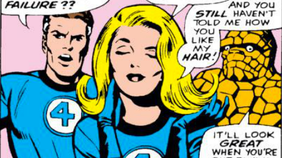Ms. Marvel, the Hero I've Been Waiting For
- hannahlien
- May 2, 2015
- 3 min read

Of all the comics that I’ve read this semester, Ms. Marvel: No Normal has been the most enjoyable, bringing with it a unique art style from Adrian Alphona and a witty and engaging story by G. Willow Wilson. Ms. Marvel makes me think of the tv shows that I watched as a child. The story is most similar to that of the Static Shock cartoon, but tonally, Ms. Marvel is also reminiscent of shows like Kim Possible. If there had been a cartoon of this comic when I was growing up, you can bet that I would have watched it. Heck, if there were a cartoon now, I would watch it.

The art style is unique, exaggerated and eye catching. One part realistic, and two parts exaggeration, Alphona’s art is perfectly suited to the story, as well as to Ms. Marvel/Kamala Khan herself. Alphona’s ability to exaggerate faces with emotion is a great fit for the story of a teenaged polymorph. The style also lends itself well to portraying Kamala’s powers, which take quite a deal of exaggeration. Alphona, I feel captures the right medium between playful and body horror, using creative imagery, such as that in page 2 of chapter 2, where Kamala is shown struggling to contain her new powers as she hurries down the streets of Jersey City. While the situation has the potential to be horrifying, Alphona’s light and cartoon-y style helps maintain the Saturday morning cartoon feel of the comic.

Moving back to the writing, I feel that Ms. Marvel is a welcome change from the nitty gritty heroes, like DC’s Batman, or even from other Marvel heroes. Following in the footsteps of other teenaged heroes, like Spider-Man, I feel that Kamala avoids the angst that plagues Peter Parker. Rather she deals with normal teenage problems, such as being grounded and getting detention as she tries to figure out her powers. She's also a fangirl for the Avengers, who spends her time gaming and writing fanfic, connecting her even more to the general comics fans, particularly female comics fans. But, just because Kamala has not had to face the death of a family member does not mean that the comics are wholly devoid of the serious.

Because Kamala is a Pakistani Muslim girl, the Wilson takes care to incorporate her culture into the series. In addition to having to figure out her powers and what it means to be a hero, Kamala has to navigate two different cultures. At school she has to deal with girls like Zoe who patronize and belittle her culture, whether knowingly or not. At home, she is shown struggling to fit her parents’ ideals, and with keeping her super-identity secret from them. Wilson is aware that Kamala belongs to both American and Pakistani Muslim culture, and writes her as wanting to be a part of both. Her cultural identity is not incidental to her character or to her super-identity, but rather helps to inform her actions, particularly her costume changes in the comic. She goes from disguising herself as a tall blonde, to simply herself but in a mask and a wholly functional costume. For many girls who are inundated with this arbitrary ideal, Kamala’s progression to fighting crime as herself is a powerful one. It speaks of self-acceptance at a time (adolescence) when that is the hardest thing a person can do.

Kamala Khan is a smart and quirky heroine, and the world could do with more like her.




















Comments